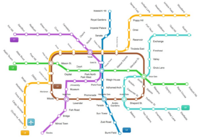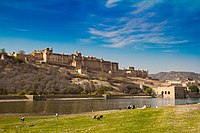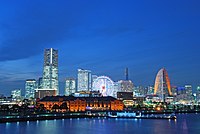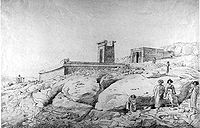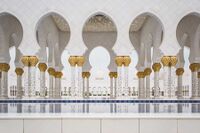List of cities in Orioni
Most cities in Orioni from the First Empire carry the classical suffix -polis (/ˈpɒlɨs/; plural poleis (/ˈpɒleɪz/, [póleːs]), which literally means "city". Historically, most of these poleis organised themselves as monarchy and mainly focussed on trade. Certain cities specialised in one particular type of commodity. Some colonies experimented with other forms of government, such as the oligarch republic of Primahoris.
Opolis
![]() O'polis (Oharic: Ohbuli), short for Omnipolis ("city of all"), is a city that welcomes visitors but is complex in both history and layout. There’s a reason that people come back time and time again: this is not a place you can fully comprehend with just one trip. The Orinese capital is both socially tolerant and deeply conservative; its businesses are often friendly but difficult to find. It’s a city where both an old monarchy and a young creative class find common ground. The original city-state led by tribeswoman Anahita that first comprised 5 city-states, and later grew into a Queendom, forming the epicentre of the Empire. In ancient times this area was also referred to as Magna Orioni ("Greater Orioni"). Both internationally and in daily conversations, the city is abbreviated to O’polis. Sites to visit: the Imperial castle, Adhamed Arch and Sun Tower
O'polis (Oharic: Ohbuli), short for Omnipolis ("city of all"), is a city that welcomes visitors but is complex in both history and layout. There’s a reason that people come back time and time again: this is not a place you can fully comprehend with just one trip. The Orinese capital is both socially tolerant and deeply conservative; its businesses are often friendly but difficult to find. It’s a city where both an old monarchy and a young creative class find common ground. The original city-state led by tribeswoman Anahita that first comprised 5 city-states, and later grew into a Queendom, forming the epicentre of the Empire. In ancient times this area was also referred to as Magna Orioni ("Greater Orioni"). Both internationally and in daily conversations, the city is abbreviated to O’polis. Sites to visit: the Imperial castle, Adhamed Arch and Sun Tower
Major cities
Andro
![]() Andro (Oharic: Entiro), from Andron (Aroman: ἀνδρών andrōn) or andronitis (ἀνδρωνῖτις andrōnitis), established itself as a city-state ruled by a line of male monarchs. This in contrast to most other city-states in the Empire which were matriarchies. The name evolved from Andropolis ("city of men") into Andro. In 1775 the Andro Academy of Fine Arts (AAFA) in Andro was there as a cost-free training centre for the printing of silk and cotton textiles, and later included the plastic arts. Furthermore, scholarships allowed many students to travel to O'polis and other Europan centres of studies, where they typically dedicated themselves to copying grandmasters' works, which was a common method of study in that era. The academy's focus evolved toward the fine arts and in 1778. The academy organised its first exhibition of prize-winning student work in 1786; in the next year's exhibition, other non-student artworks were also displayed. Other courses offered include painting, music, sculpture, architecture and other fine arts.
Andro (Oharic: Entiro), from Andron (Aroman: ἀνδρών andrōn) or andronitis (ἀνδρωνῖτις andrōnitis), established itself as a city-state ruled by a line of male monarchs. This in contrast to most other city-states in the Empire which were matriarchies. The name evolved from Andropolis ("city of men") into Andro. In 1775 the Andro Academy of Fine Arts (AAFA) in Andro was there as a cost-free training centre for the printing of silk and cotton textiles, and later included the plastic arts. Furthermore, scholarships allowed many students to travel to O'polis and other Europan centres of studies, where they typically dedicated themselves to copying grandmasters' works, which was a common method of study in that era. The academy's focus evolved toward the fine arts and in 1778. The academy organised its first exhibition of prize-winning student work in 1786; in the next year's exhibition, other non-student artworks were also displayed. Other courses offered include painting, music, sculpture, architecture and other fine arts.
Corona Borealis
![]() Corona Borealis (Oharic: Korontaj). City in the far north of the Empire. The name evolved from Boreapolis ("city of the north") into Borealis. When the civil war erupted in 1023, it forced the imperial family to flee in 1063 to the loyalist northern part of the island. Because of this, they temporarily moved the political capital to Boreapolis, prompting the name change to Corona Borealis ("northern crown").
Corona Borealis (Oharic: Korontaj). City in the far north of the Empire. The name evolved from Boreapolis ("city of the north") into Borealis. When the civil war erupted in 1023, it forced the imperial family to flee in 1063 to the loyalist northern part of the island. Because of this, they temporarily moved the political capital to Boreapolis, prompting the name change to Corona Borealis ("northern crown").
Cygnus
![]() Cygnus (Oharic: Hangsa). Colony-city found by merchants from Vega, it became famous for its high-quality metallurgy, thanks to the nearby rich ore veins in the Oromiyaa massif. The name evolved from Cygnopolis ("$meaning?") into Cygnus.
Cygnus (Oharic: Hangsa). Colony-city found by merchants from Vega, it became famous for its high-quality metallurgy, thanks to the nearby rich ore veins in the Oromiyaa massif. The name evolved from Cygnopolis ("$meaning?") into Cygnus.
- The origins of the name "Hangsa" are lost in antiquity. The name first appears in the 11th century BCE: a vassal lord from the Hangsa area sent a type of softshell turtle known as "Hangsa softshell turtle" to the Dion king as a tribute. In the 2nd century CE, historian Ying Šao wrote that the Nintoku dynasty use of the name Hangsa for the area was a continuance of its old name. https://en.wikipedia.org/wiki/Changsha
- The port of Cygnus is the largest iron ore loading port in Orioni and one of the largest in the world. Located in the XXX Region of Northern Orioni, the port recorded a throughput of over 550 million tons between 2016 and 2017. In March 2017, Port Cygnus had its record single shipment of 297.000 tons, which was aboard the HL Bedok, a 340 m long (1,115-foot) vessel from Miiros. http://dailyoverview.tumblr.com/post/177768196524/port-hedland-is-the-largest-iron-ore-loading-port
Dion
![]() Dion (Oharic: Dion). City of king Dion, who believed he had magical powers that granted his forests exceptional quality. Dion was a major exporter of timber for shipbuilding. The name evolved from Dionpolis ("city of Dion") into Dion. The Dion Naval Base is a nearby military facility.
Dion (Oharic: Dion). City of king Dion, who believed he had magical powers that granted his forests exceptional quality. Dion was a major exporter of timber for shipbuilding. The name evolved from Dionpolis ("city of Dion") into Dion. The Dion Naval Base is a nearby military facility.
Gruis
![]() Gruis (Oharic: Crus). The city known for its massive harbour cranes. It was the most important transfer port between the central and northern regions. The name evolved from Gripolis ("city of cranes") into Gruis.
Gruis (Oharic: Crus). The city known for its massive harbour cranes. It was the most important transfer port between the central and northern regions. The name evolved from Gripolis ("city of cranes") into Gruis.
Meda
![]() Meda (Oharic: Mideya) is one of the oldest cities in Orioni. Meda is a changed city. The recent metamorphosis has been fuelled by the economic crisis and led by a new generation of determined Medanese who have transformed the old city for the better. Tradition and modernity thrive side by side: marvel at the centuries-old masterpieces inside the Prado one moment and enjoy morsels cooked up by a new wave of intrepid chefs the next.
Meda (Oharic: Mideya) is one of the oldest cities in Orioni. Meda is a changed city. The recent metamorphosis has been fuelled by the economic crisis and led by a new generation of determined Medanese who have transformed the old city for the better. Tradition and modernity thrive side by side: marvel at the centuries-old masterpieces inside the Prado one moment and enjoy morsels cooked up by a new wave of intrepid chefs the next.
The former capital city of the Medani Empire, the city is named after the goddess Medea, a renowned sorceress and daughter of the sun goddess Osiri. The inhabitants of Meda were known as experienced sailors, many of whom longed for a return to the original homeland of Amma. They call this desire nostoi. To support their endeavour the cult of Medea used up vast amounts of resources, sadly never achieving their goal. Other cities continued selling goods to Medea, while the city itself wasted all on their hopeless quest. This story gave easterners the reputation of being stubborn and wasteful.
One famous story from Meda is the legend of the Stoned Emperor. People believe the last Medanese Emperor Debideba didn't die at the Siege of Meda but was taken by angels, which turned him into stone and placed him at the bottom of the Torineti gulf. And that when the time comes, he'll rise again and take back the city.
Nordhaven
![]() Nordhaven (Oharic: Uttura). A city founded in 1131 that started out as a Viking settlement during the 11-12th-century crisis. The site lay beside the seaway from north to south Europa. In Oharic the city is referred to as Uttara ("harbour of the north"), although in daily conversations they use the name Nordhaven.
Nordhaven (Oharic: Uttura). A city founded in 1131 that started out as a Viking settlement during the 11-12th-century crisis. The site lay beside the seaway from north to south Europa. In Oharic the city is referred to as Uttara ("harbour of the north"), although in daily conversations they use the name Nordhaven.
Oris
![]() Oris (Oharic: Horisi) was named after Horis, the god of war. The ancient city was run as an oligarchic republic. Its financial clout reached soaring levels thanks to its important role in the now-forbidden regional slave trade. The name evolved from Primahoris ("first warriors") into Oris. This location is currently used by the Oris Naval Base.
Oris (Oharic: Horisi) was named after Horis, the god of war. The ancient city was run as an oligarchic republic. Its financial clout reached soaring levels thanks to its important role in the now-forbidden regional slave trade. The name evolved from Primahoris ("first warriors") into Oris. This location is currently used by the Oris Naval Base.
At present, it is a city that hits you between the eyes with its natural beauty, glorious coastline, dramatic mountains and urban rainforest. But there’s plenty to discover here that isn’t instantly self-evident. From lively neighbourhood bars and intricate beach culture to sculptural gardens and concrete modernist buildings, there is a lot more to Oris than bronzed bodies on Ikurē Beach.
Perseus
![]() Perseus (Oharic: Parishya). City bids home to the Persei tribe, renowned for their intricate textiles. The name evolved from Persipolis ("city of the Persei") into Persis, and later became Perseus. This location is currently used by the Perseus Naval Base.
Perseus (Oharic: Parishya). City bids home to the Persei tribe, renowned for their intricate textiles. The name evolved from Persipolis ("city of the Persei") into Persis, and later became Perseus. This location is currently used by the Perseus Naval Base.
Inspiration backlog:
Pontus
![]() Pontus (Oharic: Bandas). A city that is known for its fish exports and whale hunting. Its excellent location on both the high-seas and enclosed sea provided for a diverse supply of marine food. The name evolved from Pontipolis ("city of the sea") into Pontis, and later became Pontus.
Pontus (Oharic: Bandas). A city that is known for its fish exports and whale hunting. Its excellent location on both the high-seas and enclosed sea provided for a diverse supply of marine food. The name evolved from Pontipolis ("city of the sea") into Pontis, and later became Pontus.
Sirius
![]() Sirius (Oharic: Siriyus). A city known for its wheat export, produced by its productive hinterland on the fertile western plains. This compact and environmentally conscious city of 1.2 million people has a bountiful urban environment: miles of lush parks and a striking blend of contemporary and historic architecture. It’s also the birthplace of New Irishan cuisine and Orinese Modern design, and the quality of the food, drink and shopping upholds these legacies. For seven days from mid- to late April, the Cerealia was celebrated, a major festival for the grain goddess Ceres. The name evolved from Cerespolis ("city of bread") into Sirius.
Sirius (Oharic: Siriyus). A city known for its wheat export, produced by its productive hinterland on the fertile western plains. This compact and environmentally conscious city of 1.2 million people has a bountiful urban environment: miles of lush parks and a striking blend of contemporary and historic architecture. It’s also the birthplace of New Irishan cuisine and Orinese Modern design, and the quality of the food, drink and shopping upholds these legacies. For seven days from mid- to late April, the Cerealia was celebrated, a major festival for the grain goddess Ceres. The name evolved from Cerespolis ("city of bread") into Sirius.
Tauri
![]() Tauri (Oharic: Dari) is located in Alnilam on the northern edge of the Oromiyaa massif and plateau. The Taurini are an ancient people, rarely mentioned in history. They were mostly farmers and collectors of nuts. In 218 BCE they were conquered by the First Empire of Orioni and a colony was established shortly thereafter.
Tauri (Oharic: Dari) is located in Alnilam on the northern edge of the Oromiyaa massif and plateau. The Taurini are an ancient people, rarely mentioned in history. They were mostly farmers and collectors of nuts. In 218 BCE they were conquered by the First Empire of Orioni and a colony was established shortly thereafter.
Vega
![]() Vega is city located on the Caroni river. The name Vega comes from a loose transliteration of the Oharic word na-sran la vāqi‘ meaning "the landing eagle". The 'eagle' was a ship type that could sail in both coastal waters and on rivers, making it an ideal transport for small traders. Colonists from Vega founded the northern daughter-city of Cygnus. This location is currently used by the Vega Naval Base.
Vega is city located on the Caroni river. The name Vega comes from a loose transliteration of the Oharic word na-sran la vāqi‘ meaning "the landing eagle". The 'eagle' was a ship type that could sail in both coastal waters and on rivers, making it an ideal transport for small traders. Colonists from Vega founded the northern daughter-city of Cygnus. This location is currently used by the Vega Naval Base.
Zuidhaven
![]() Zuidhaven (Oharic: Ierakshini). A city located in the Orinoco river delta south of O'polis. Beneath its inimitable skyline Zuidhaven is a teeming, triumphant metropolis with imperial history, intrigue and entrepreneurial zeal written into its streets. It’s a city constantly being remade and reimagined, and the resulting sense of opportunity and vigour is palpable. From the domes of its temples to the frantic pace of its traffic, Istanbul is awe-inspiring, unflinchingly and gregariously urban. The original name was either Hierropolis ("iron city") or Hierapolis ("sacred city"). The city earned its wealth thanks to the trade of ores. Sidi Adhamed sacked the city in 1174, marking the end of the civil war. In 1224 a band of Borean merchants re-founded the city as Zuidhaven ("harbour of the south"), drawing inspiration from earlier successes in Nordhaven. In Oharic the city was referred to as Irebuli. Zuidhaven is the nation's economic centre, with a population of over 10 million inhabitants. The unofficial metropolitan area extends far beyond, housing about 13 million inhabitants, granting it the classification as a megalopolis.
Zuidhaven (Oharic: Ierakshini). A city located in the Orinoco river delta south of O'polis. Beneath its inimitable skyline Zuidhaven is a teeming, triumphant metropolis with imperial history, intrigue and entrepreneurial zeal written into its streets. It’s a city constantly being remade and reimagined, and the resulting sense of opportunity and vigour is palpable. From the domes of its temples to the frantic pace of its traffic, Istanbul is awe-inspiring, unflinchingly and gregariously urban. The original name was either Hierropolis ("iron city") or Hierapolis ("sacred city"). The city earned its wealth thanks to the trade of ores. Sidi Adhamed sacked the city in 1174, marking the end of the civil war. In 1224 a band of Borean merchants re-founded the city as Zuidhaven ("harbour of the south"), drawing inspiration from earlier successes in Nordhaven. In Oharic the city was referred to as Irebuli. Zuidhaven is the nation's economic centre, with a population of over 10 million inhabitants. The unofficial metropolitan area extends far beyond, housing about 13 million inhabitants, granting it the classification as a megalopolis.
Minor cities
- Anada Varaba is a port city in Orioni’s Semeni region, with a history dating to the Middle Ages.
- Lumbini is an Elitist pilgrimage site in the Amilaki region. It is the place where, according to religious tradition, the first Elite revolution against corrupt rulers took place in 563 CE.
- Mar (common pronunciation) or Mor is a title of honour given to saints. The Pope of Salvia is referred to as Mar Baba by the Orinese.
Former cities
- Arrochar
- Doriapolis ("city of Dorias”). A city ruled by Dorias I the Great and famous for its library. The city lost much of its former glory when local power shifted towards O'polis. It was ultimately abandoned in 356 CE.
- Eridanus ("city of the river"). A city located near the inlet east of Sirius. Abandoned when its river dried out. The name lives on as Eridanus bay.
- Iskandropolis (“city of Iskander”). City founded by Iskander, a general from Andro(polis) who was a crucial figure in the colonisation of the northeast. The name lives on as a reference to the Hiskandria river.
- Ophir (Oharic: Oper). From the ancient Memopotamian symbol Pr meaning 'house' or 'house of'. City on the coast that grew rich thanks to its trade in timber and ores. The exact location of Ophir is uncertain because any architecture left behind would have almost disappeared considering the great timescale. The city is most likely buried somewhere in central Orioni, specifically along the river delta region between Vega and Zuidhaven
- Tarabulus (Anglish: Tripolis, "three cities"). A city that started out as a collection of three cities, located in the inlet of Great Sea of Dragon Tears ($Rename). The city was lost in 79 CE when a massive landslide pushed the entire city into the sea. There are also various legends of medieval origin about cities that sank underground or into the sea because of some collective sin committed by the inhabitants. These towns return to earth every hundred years for a few hours, only to sink back to their eternal existence in perpetual limbo. Seeing this as an omen from the gods, no effort was made to re-found the city.
This template may be deleted.
